|
Sumpter Valley Railway History 1889-1961 |
|
|
Background David Eccles first passed through northeastern Oregon as an eighteen year old about 1867. David's parents converted the family to Mormonism while living in Scotland in the 1840s, and the family emigrated to the United States in 1863. Rumors of good prospects in the Willamette Valley drew the Eccles Family from Utah Territory to Oregon, and they stayed for two years before returning east. David became a prolific businessman after the family returned to Utah, with a particular emphasis in the lumber business. Eccles returned to Oregon by the early 1880s, where he became involved in a series of lumber operations with a couple partners. In 1889, Charles W. Nibley, one of David's associates, learned of a large block of fine timber up the Powder River west of Baker City from a county surveyor. Nibley let David know immediately, and by the end of 1889 Eccles, Nibley, and a group of others incorporated the Oregon Lumber Company. The Oregon Lumber Company promptly secured harvesting rights to the timber. |
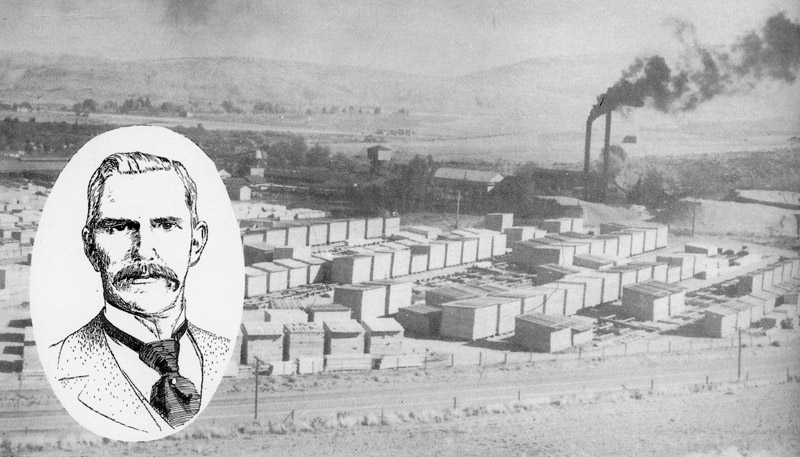
A drawing of David Eccles superimposed over a picture of the Oregon Lumber Company sawmill
at Baker City, from a truck logging handbook issued in 1941 by the Pacific Logging Conference. |
|
First Construction Efforts The Oregon Lumber Company quickly decided it would need a railroad to tap the timber. By early 1890, the company had an agreement with Union Pacific in which UP agreed to supply rails and other equipment to the lumber company, along with a contract to purchase 500,000 ties a year for five years. The help and assistance provided by the UP immediately gave the new venture an incredibly strong base from which to work, and on 18 August 1890 the principles behind the Oregon Lumber Company incorporated the Sumpter Valley Railway Company to handle the rail operations. Union Pacific had inherited or purchased a substantial narrow gauge network, especially in southeastern Idaho and northern Utah, and was in the process of converting those lines to standard gauge as the Oregon Lumber Company launched its venture. The Sumpter Valley Railway chose to build its railroad to narrow (three foot) gauge due in large part to the availability of used Union Pacific equipment. UP delivered the first locomotive and track materials to Baker City in late summer 1890, and construction commenced immediately. Heavy snows forced a lengthy suspension of work during the winter, but the spring thaw allowed the railroad to finish its main line as far as Milepost 19 by July 1891. The railroad's only locomotive brought the first log train into Baker City on 1 August 1891. Futher contruction brought the railhead to McEwan, Oregon, in October 1891. Three lumber companies- Oregon Lumber Company, Baker White Pine Lumber Company, and and Stoddard Lumber Company (headed by John Stoddard, David's father-in-law)- all built substantial sawmills at Baker City and logging railroads off the other end of the line. The Sumpter Valley Railroad boomed from the start, offering both passenger and freight traffic over its completed line. Raw logs provided the bulk of the freight business. |
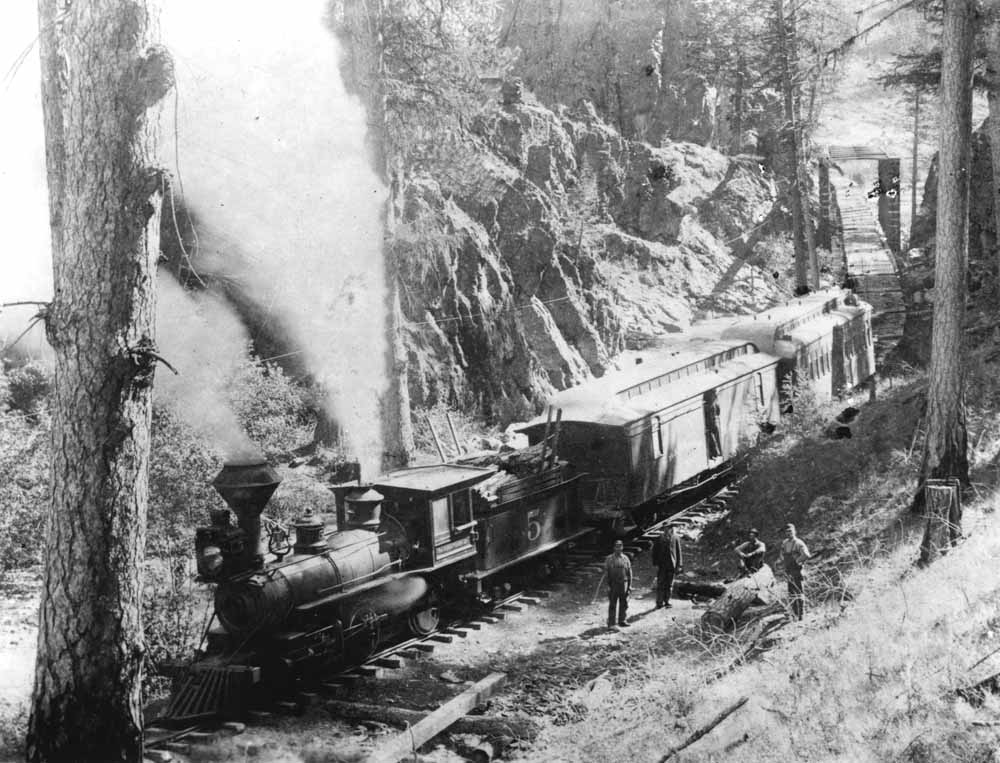 Sumpter Valley #5 with a mixed passenger and freight train in Boulder Gorge in 1908. John T. Labbe Collection of Logging and Railroad Photographs, 1892-2010, Washington State Archives, Digital Archives, http://www.digitalarchives.wa.gov. |
|
Extension to Sumpter and Beyond The end of track at McEwan lay only about four miles from Sumpter, a mining camp formed in 1862 when five ex-Confederate soldiers found gold at the site. The discovery of rich veins of gold quartz about 1892 finally prompted the Sumpter Valley Railroad to extend the main line into the camp. The Sumpter Valley Railroad completed its line into Sumpter on 3 October 1896. Sumpter immediately bloomed into a small city with the arrival of the railroad, and the Sumpter Valley Railroad schedule showed four passenger trains each way per day over the length of the main line. The railroad did not stop at Sumpter, however, as the various lumber companies associated with the railroad had timber holdings and contracts to the west. The railroad built a wye a short distance south of Sumpter, with the tail of the wye forming the start of a new mainline extending to the southwest. The first extension winding up Huckleberry Mountain reached the summit at Larch around 1900. The railhead next reached the new town of Whitney on 1 June 1904. Further extension brought the line to the next summit at Tipton, completed in June 1904. The last of these extension carried the line to Austin in November 1905. Each of these extensions opened up vast new timberlands to development, and the various lumber companies built sawmills and/or new logging railroads tributary to the mainline. |
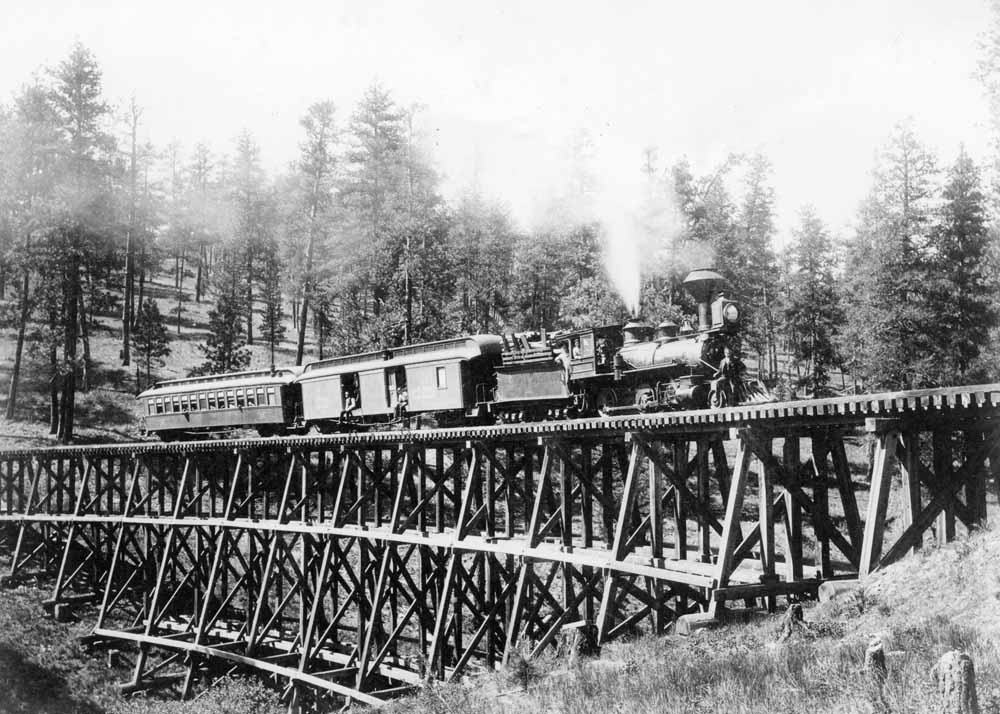 Sumpter Valley #1 with a passenger train on the Alder Creek trestle. John T. Labbe Collection of Logging and Railroad Photographs, 1892-2010, Washington State Archives, Digital Archives, http://www.digitalarchives.wa.gov. |
|
The railroad had not quite reached its final form, however. Far to the southwest, the
Nevada-California-Oregon Railroad
had been struggling north from Reno, Nevada, with a stated intention of reaching the Columbia River.
After a slow start, the N-C-O by 1900 was finally showing good progress, though the railhead only
reached Alturas, California, by December 1908. The Sumpter Valley management decided to extend
their railroad to a new connection with the projected N-C-O line at Prineville, and by early 1909 track
laying forces again resumed the forward march. The last extension of the Sumpter Valley mainline
carried the railroad over another mountain summit by means of switchbacks before decending to the
town of Prairie City in the John Day River valley. The first Sumpter Valley train rolled over the
eighty miles of track between Baker City and Prairie City on 4 July 1910. While the Prairie City
extension brought the railroad new business, the dreams of connecting to another railroad failed to
materialize. The N-C-O struggled into Lakeview, OR, in January 1912, but could build no farther.
Sumpter Valley continued contemplating extending their line to the south and east at least through
1912, when a shakeup in the Eccles Family resulted in a change of railroad management and forever
ended the possibility of any additional extensions. The Glory Years The Sumpter Valley Railway boomed through the late 1910s and the early 1920s. The mining traffic started to tail off significantly as the mines around Sumpter and Greenhorn played out, especially after a fire leveled most of the town of Sumpter in August 1917. The Prairie City extension brought significant agricultural traffic to the railroad, and the company also handled substantial livestock shipments from all points on the line, especially during the fall months. However, logs and lumber remained the carrier's bread and butter. Following is a list of the most important log and lumber shippers the railroad served: - C.W. Nibley built a mill at Whitney in 1911 that burned in 1915. - Baker White Pine, organized by Frank Gardiner, built a mill at White Pine in 1912. That mill operated until the early 1920s, when the company moved the mill to a new site at Curry. Baker White Pine folded and sold their operations to Stoddard Lumber Company in 1929, which ran the Curry mill until 1931 and shipped logs to Baker City thereafter. - Stoddard Brothers Lumber Company built a small mill in the McEwan vicinity around 1892, replaced shortly by a larger mill built in Baker City. The Stoddards renamed their company Stoddard Lumber Company in 1914 and then purchased the Baker White Pine company in 1929. Stoddard continued shipping logs down to Baker City until 1943. - W.C. Eccles Lumber Company built a mill at Austin in 1911. This mill vanished by 1926 when the company moved its operations to Idaho. - Gardiner or Cavanaugh Lumber Company was Frank Gardiner's second attempt at the lumber industry after Baker White Pine failed. Cavanaugh/Gardiner built a small mill in Austin and logged some of the remaining Eccles timber that company left behind when they moved to Idaho. Gardiner probably used some of the W.H. Eccles company locomotives on this operation, which lasted into the very late 1920s. - Oregon Lumber Company continued to provide the majority of the traffic. They opened a mill at Austin about 1905, which lasted until 1919 when the company built a larger and more modern mill at the new town of Batesville (later shortened to just Bates). Oregon Lumber Company built a second mill at Whitney in 1928. These mills eliminated most of the Oregon Lumber Company log traffic the railroad handled, but in turn produced vast quantities of rough cut lumber the railroad hauled to Baker City for finishing. |
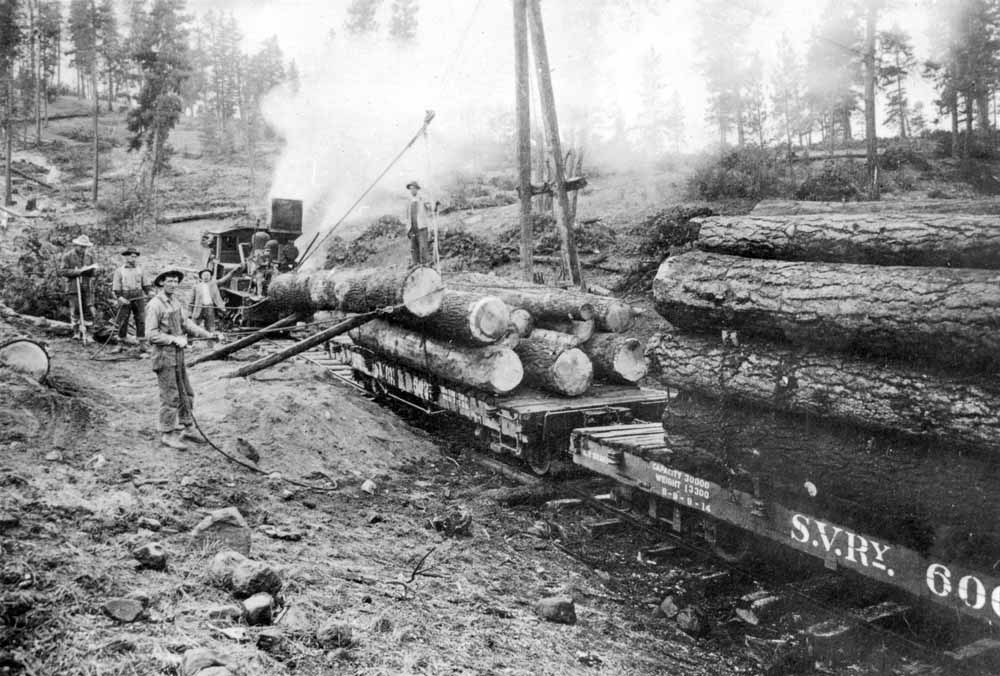 Sumpter Valley log flats being loaded on one of the logging railroads using a donkey engine on the front of the locomotive and an A-frame boom. John T. Labbe Collection of Logging and Railroad Photographs, 1892-2010, Washington State Archives, Digital Archives, http://www.digitalarchives.wa.gov. |
|
In addition to the sawmill operations, each of these companies also operated logging railroads tributary
to the Sumpter Valley mainline. The companies collectively built several hundred miles of temporary
railroads through the woods during the operating years. The prosperity all this traffic provided allowed the railroad to substantially modernize its property starting in the 1920s. A series of new locomotives from Alco and Baldwin replaced the hand-me-down power the railroad started with, and two sets of new passenger equipment built new for the road by American Car & Foundry allowed the railroad to operate first class passenger service over the length of the line. As usually happens, those living around the railroad tagged the line with various nicknames, two of which stuck. The more popular one, and the name the railroad semi-officially adopted, was the Stump Dodger in reference to the twisty nature of the line; the other, uttered under more hushed tones, was the Polygamy Central in reference to the Mormon faith of the management and ownership. |
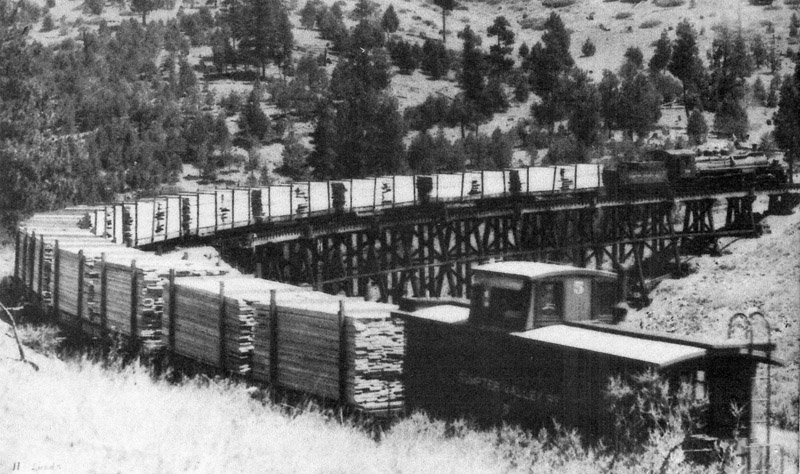
A lumber train behind one of Sumpter Valley's famous articulateds on the return to Baker City,
from a truck logging handbook issued in 1941 by the Pacific Logging Conference. |
|
Decline and Abandonment By the early 1930s, automobile competition and improving roads started cutting into the railroad's business. First affected was the passenger business and all traffic to and from Prairie City. Operations beyond Bates trailed off to nearly nothing, and the Interstate Commerce Commission authorized abandonment of the line in January 1933. The passenger trains disappeared next, making their last run on 31 July 1937. Passengers then rode in cabooses on freight trains, which continued to haul green lumber from the Oregon Lumber Company mills in Bates and Whitney down to Baker City in enough quantities to keep the railroad healthy. The railroad gained substantial recognition in 1940 when the company purchased two Baldwin built 2-6-6-2T articulated locomotives from the Uintah Railway. The pair stood out as the largest narrow gauge steam locomotives built in North America, and they fit in well on the railroad. However, they could not postpone the inevitable. Despite remaining profitable up until the end, the Oregon Lumber Company decided the railroad had outlived its usefulness. The mill at Whitney closed in 1943 when the timber available to it finally ran out; the mill at Bates still had a secure future, but the Oregon Lumber Company decided to replace the railroad with trucks. The last Sumpter Valley Railway freight operated on 11 April 1947. The railroad removed the rails from the mainline shortly after the last train ran and gathered all equipment into the yards at Baker City. The company scrapped a few pieces of equipment but found willing buyers for most of it. Railcars tend to be well built, and many Sumpter Valley cars ended up as sheds and outbuildings around the country. Most equipment, however, departed for new homes in either Alaska or South America. The railroad did not die entirely, however, as a small trace of the operation remained. A good deal of dual gauge switching trackage serviced most of the Baker City sawmill, and the last trace of the Sumpter Valley Railroad continued operations with a small narrow gauge gas mechanical locomotive the company used to switch standard gauge cars inside the plant. The Edward Hines Lumber Company purchased the Oregon Lumber Company in 1955 and continued operating the mill until 1961, when it finally closed and the last vestige of the Sumpter Valley Railway finally disappeared. Hines continued operating the mill at Bates until 1974, when it too finally closed. Thus ended the life of the original Sumpter Valley Railway. However, the story did not end there. |
|
|
|
|